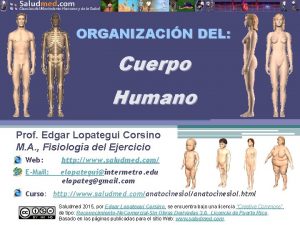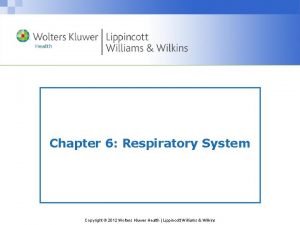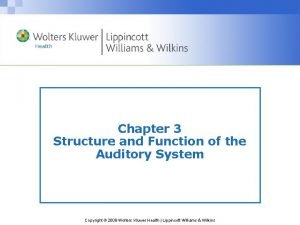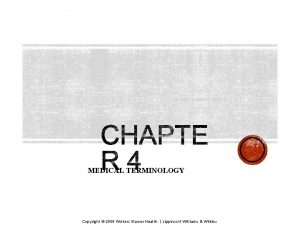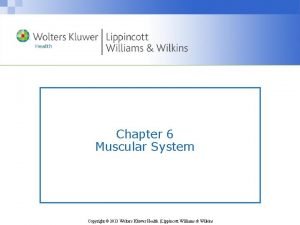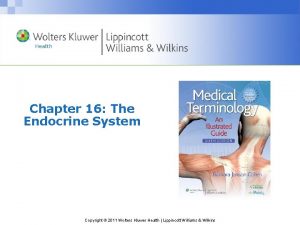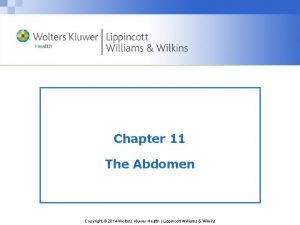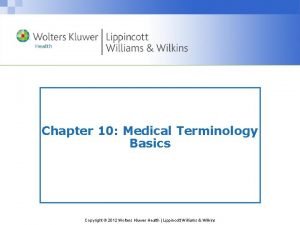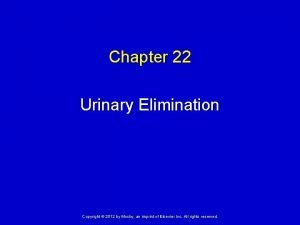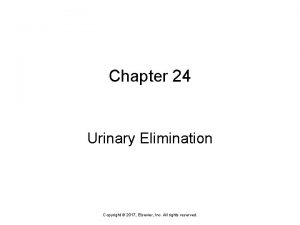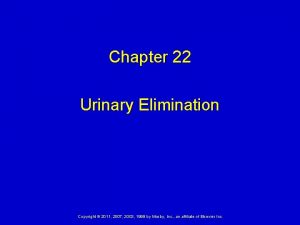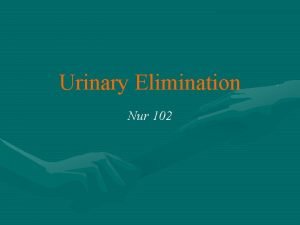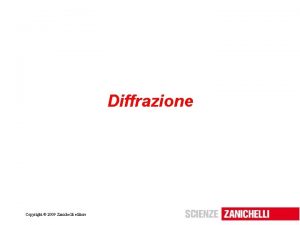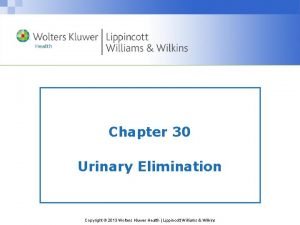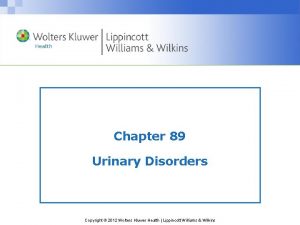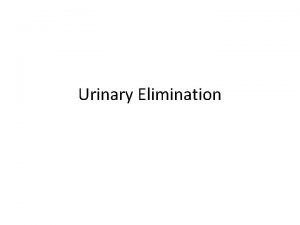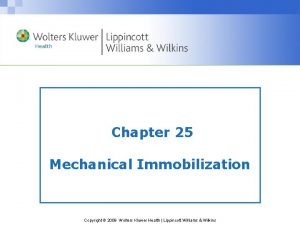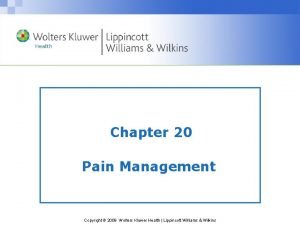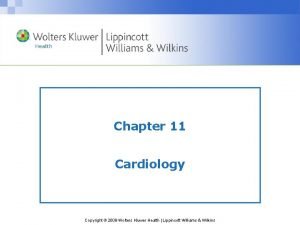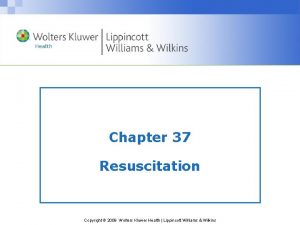Chapter 30 Urinary Elimination Copyright 2009 Wolters Kluwer



































- Slides: 35

Chapter 30 Urinary Elimination Copyright © 2009 Wolters Kluwer Health | Lippincott Williams & Wilkins

Copyright © 2009 Wolters Kluwer Health | Lippincott Williams & Wilkins

Overview of Urinary Elimination • Components of the urinary system: kidneys, ureters, bladder, and urethra • Accessory structures of the urinary system: ring-shaped muscles; internal and external sphincters – Components, along with accessory structures, work together to produce urine, collect it, and excrete it from the body Copyright © 2009 Wolters Kluwer Health | Lippincott Williams & Wilkins

Overview of Urinary Elimination (cont’d) • Urinary elimination: process of releasing excess fluid and metabolic wastes – Normal conditions: average person eliminates approximately 1500 to 3000 m. L of urine each day – Need to urinate becomes apparent when the bladder distends with approximately 150 to 300 m. L of urine Copyright © 2009 Wolters Kluwer Health | Lippincott Williams & Wilkins

Overview of Urinary Elimination (cont’d) • Patterns of urinary elimination – Physiologic – Emotional – Social o Examples: amount of food consumed, volume of fluid intake, and the amount of fluid losses Copyright © 2009 Wolters Kluwer Health | Lippincott Williams & Wilkins

Overview of Urinary Elimination (cont’d) • Measures to promote urination – Providing privacy; assuming a natural position for urination – Maintaining an adequate fluid intake – Using stimuli such as running water from a tap to initiate voiding Copyright © 2009 Wolters Kluwer Health | Lippincott Williams & Wilkins

Characteristics of Urine Copyright © 2009 Wolters Kluwer Health | Lippincott Williams & Wilkins

Urine Specimen Collection • Purpose: to identify microscopic or chemical constituents of client’s urine – Voided specimens: sample of fresh urine collected in a clean container – Clean-catch specimens: voided sample of urine considered sterile o Also termed midstream specimen because of how it is collected Copyright © 2009 Wolters Kluwer Health | Lippincott Williams & Wilkins

Collecting a Clean-Catch Specimen Copyright © 2009 Wolters Kluwer Health | Lippincott Williams & Wilkins

Specimens of Urine • Catheter specimens: urine specimen collected under sterile conditions using a catheter, which is usually done when clients are catheterized for other reasons such as to control incontinence in an unconscious client • 24 -hour specimens: collection of all urine produced in a full 24 -hour period Copyright © 2009 Wolters Kluwer Health | Lippincott Williams & Wilkins

Location for Collecting a Catheter Specimen Copyright © 2009 Wolters Kluwer Health | Lippincott Williams & Wilkins

Abnormal Urinary Elimination Patterns • Identifying abnormal urine characteristics – Laboratory analysis is a valuable diagnostic tool o Hematuria: urine containing blood o Albuminuria: urine containing albumin, a plasma protein Copyright © 2009 Wolters Kluwer Health | Lippincott Williams & Wilkins

Abnormal Urinary Elimination Patterns (cont’d) • Pyuria: urine containing pus • Proteinuria: urine containing plasma proteins • Glycosuria: urine containing glucose • Ketonuria: urine containing ketones Copyright © 2009 Wolters Kluwer Health | Lippincott Williams & Wilkins

Abnormal Urinary Elimination Patterns (cont’d) • Anuria: absence of urine or a volume of 100 m. L or less in 24 hours; kidneys not producing sufficient urine – Urinary retention: the client produces urine but does not release it from the bladder Copyright © 2009 Wolters Kluwer Health | Lippincott Williams & Wilkins

Abnormal Urinary Elimination Patterns (cont’d) • Oliguria: urine output is less than 400 m. L per 24 hours; indicates inadequate elimination of urine – Residual urine: more than 50 m. L of urine remains in the bladder after voiding – Urinary stasis: lack of movement of urine from bladder Copyright © 2009 Wolters Kluwer Health | Lippincott Williams & Wilkins

Abnormal Urinary Elimination Patterns (cont’d) • Polyuria: greater than normal urinary volume; may accompany minor dietary variations, such as increased fluid intake – Disorders: diabetes mellitus, an endocrine disorder caused by insufficient insulin; and diabetes insipidus, an endocrine disease caused by insufficient antidiuretic hormone • Nocturia: nighttime urination Copyright © 2009 Wolters Kluwer Health | Lippincott Williams & Wilkins

Abnormal Urinary Elimination Patterns (cont’d) • Dysuria: difficult or uncomfortable voiding and a common symptom of trauma to the urethra or a bladder infection – Frequency: need to urinate often – Urgency: strong feeling that urine must be eliminated quickly • Incontinence: inability to control either urinary or bowel elimination; abnormal after a person is toilet-trained Copyright © 2009 Wolters Kluwer Health | Lippincott Williams & Wilkins

Copyright © 2009 Wolters Kluwer Health | Lippincott Williams & Wilkins

Assisting Clients With Urinary Elimination • Clients who are weak or cannot walk to the bathroom may need a commode; clients confined to bed use a urinal or bedpan – Commode: chair with an opening in the seat under which a receptacle is placed – Urinal: cylindrical container for collecting urine; mostly used for males Copyright © 2009 Wolters Kluwer Health | Lippincott Williams & Wilkins

Assisting Clients With Urinary Elimination (cont’d) • Using a bedpan: a seatlike container for elimination • Fracture pan, a modified version of a conventional bedpan – Clients with musculoskeletal disorders who cannot elevate their hips to sit on a bedpan in the usual manner use a fracture pan Copyright © 2009 Wolters Kluwer Health | Lippincott Williams & Wilkins

Two Types of Bedpans: Fracture Pan (Left), Conventional Pan (Right) Copyright © 2009 Wolters Kluwer Health | Lippincott Williams & Wilkins

Managing Incontinence • 6 types of urinary incontinence – Stress, urge, reflex, functional, total, and overflow • Continence training: to restore control of urination involves teaching the client to refrain from urinating until an appropriate time and place Copyright © 2009 Wolters Kluwer Health | Lippincott Williams & Wilkins

Types of Incontinence Copyright © 2009 Wolters Kluwer Health | Lippincott Williams & Wilkins

Copyright © 2009 Wolters Kluwer Health | Lippincott Williams & Wilkins

Catheterization • Catheterization: act of applying or inserting a hollow tube • Types of catheters – External catheters: urine-collecting device applied to the skin o Example: condom catheter Copyright © 2009 Wolters Kluwer Health | Lippincott Williams & Wilkins

Catheterization (cont’d) • Straight catheters: urine drainage tube inserted but not left in place • Retention catheters (also called indwelling catheters): left in place for a period of time – Example: Foley catheter Copyright © 2009 Wolters Kluwer Health | Lippincott Williams & Wilkins

Catheterization (cont’d) • Inserting a catheter: techniques for inserting straight and retention catheters are similar, although the steps for inflating the retention balloon do not apply to a straight catheter • Closed drainage system: device used to collect urine from a catheter Copyright © 2009 Wolters Kluwer Health | Lippincott Williams & Wilkins

Catheterization (cont’d) • Closed drainage system components: – Calibrated bag – Tubing of sufficient length – Hanger Copyright © 2009 Wolters Kluwer Health | Lippincott Williams & Wilkins

Catheterization (cont’d) • Providing catheter care: hygiene measures used to keep the meatus and adjacent area of the catheter clean • Catheter irrigation: flushing the lumen of a catheter – Open system: retention catheter is separated from the drainage tubing to insert the tip of an irrigating syringe Copyright © 2009 Wolters Kluwer Health | Lippincott Williams & Wilkins

Providing Catheter Care Copyright © 2009 Wolters Kluwer Health | Lippincott Williams & Wilkins

Catheterization (cont’d) • Catheter irrigation (cont’d) – Closed system: irrigated without separating the catheter from the drainage tubing – Continuous irrigation: ongoing instillation of solution using a 3 -way catheter Copyright © 2009 Wolters Kluwer Health | Lippincott Williams & Wilkins

Catheterization (cont’d) • Indwelling catheter removal: catheter is removed when it needs to be replaced or when its use is discontinued Copyright © 2009 Wolters Kluwer Health | Lippincott Williams & Wilkins

Removing a Foley Catheter Copyright © 2009 Wolters Kluwer Health | Lippincott Williams & Wilkins

Urinary Diversions • Urinary diversion: one or both ureters are surgically implanted elsewhere – This procedure is done for various lifethreatening conditions – Urostomy: urinary diversion that discharges urine from an opening on the abdomen o Peristomal skin: skin around the stoma Copyright © 2009 Wolters Kluwer Health | Lippincott Williams & Wilkins

Nursing Implications • Potential nursing diagnoses: – Self-care deficit: toileting – Risk for infection, impaired skin integrity – Functional; stress; urge; reflex; total urinary incontinence – Impaired urinary elimination Copyright © 2009 Wolters Kluwer Health | Lippincott Williams & Wilkins
 Wolters kluwer health
Wolters kluwer health Wolters kluwer health
Wolters kluwer health Wolters kluwer
Wolters kluwer Wolters kluwer
Wolters kluwer Wolters kluwer
Wolters kluwer Wolters kluwer health
Wolters kluwer health Wolters kluwer health
Wolters kluwer health Wolters kluwer
Wolters kluwer Wolters kluwer
Wolters kluwer Wolters kluwer
Wolters kluwer Wolters kluwer
Wolters kluwer Wolters kluwer
Wolters kluwer Wolters kluwer health
Wolters kluwer health Wolters kluwer
Wolters kluwer Virchows triad
Virchows triad Wolters kluwer pronunciation
Wolters kluwer pronunciation Wolters kluwer
Wolters kluwer Chapter 48 skin integrity and wound care
Chapter 48 skin integrity and wound care Wolters kluwer
Wolters kluwer Wolters kluwer
Wolters kluwer Physical examination techniques
Physical examination techniques Wolters kluwer ovid
Wolters kluwer ovid Wolters kluwer health lippincott williams & wilkins
Wolters kluwer health lippincott williams & wilkins Wolters kluwer culture
Wolters kluwer culture Wolters kluwer pronunciation
Wolters kluwer pronunciation Chapter 22 urinary elimination
Chapter 22 urinary elimination Chapter 24 urinary elimination
Chapter 24 urinary elimination Chapter 22 urinary elimination
Chapter 22 urinary elimination Nur 102
Nur 102 Alterations in urinary elimination
Alterations in urinary elimination Gauss vs gauss jordan
Gauss vs gauss jordan 2009 pearson education inc
2009 pearson education inc Copyright international color consortium, 2009
Copyright international color consortium, 2009 Dell all rights reserved copyright 2009
Dell all rights reserved copyright 2009 Copyright 2009 pearson education inc
Copyright 2009 pearson education inc Diffrazione luce zanichelli
Diffrazione luce zanichelli


